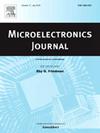Design of a low-power Digital-to-Pulse Converter (DPC) for in-memory-computing applications
IF 1.9
3区 工程技术
Q3 ENGINEERING, ELECTRICAL & ELECTRONIC
引用次数: 0
Abstract
Data converters such as analog-to-digital converters (ADCs), digital-to-analog converters (DACs), digital-to-time converters (DTCs), time-to-digital converters (TDCs), among others, are considered some of the most essential blocks in the field of integrated circuit design. In this work, we introduce a novel type of data converter known as the Digital-to-Pulse converter (DPC) and present its novel analog flow circuit implementation. The DPC system is a critical component in emerging artificial neural network accelerators and in-memory computing systems. The DPC system presented in this study offers two distinct operating modes. The first mode is the generation of a single pulse with a width that is modulated by the digital input. The second mode is an n-bit digital to discrete pulse converter, where the number of generated pulses is directly related to the value of the digital input. The proposed DPC system offers designers a high level of flexibility in shaping the characteristics of the output pulses, including the number of pulses, pulse width, and pulse amplitude. This empowers designers to accommodate different application requirements and scenarios effectively. The proposed circuit has been verified and tested using Virtuoso Cadence circuit tools in 180 nm CMOS technology with post-layout simulation and analysis. The results indicate a significant enhancement in average power consumption (), layout area (), and latency () with the proposed system compared to the digital Register Transfer Level (RTL) implementation under a power supply of 1.8V and a clock frequency of 1 GHz in the Application Specific Integrated Circuits (ASIC) flow. This demonstrates the suitability of the proposed system for low-power and high-speed applications.
为内存计算应用设计低功耗数字脉冲转换器 (DPC)
模数转换器 (ADC)、数模转换器 (DAC)、数时转换器 (DTC)、时数转换器 (TDC) 等数据转换器被认为是集成电路设计领域最基本的模块。在这项工作中,我们介绍了一种新型数据转换器,即数字到脉冲转换器(DPC),并介绍了其新型模拟流电路实现方法。DPC 系统是新兴人工神经网络加速器和内存计算系统的重要组成部分。本研究中介绍的 DPC 系统提供两种不同的工作模式。第一种模式是生成宽度受数字输入调制的单脉冲。第二种模式是 n 位数字到离散脉冲转换器,生成脉冲的数量与数字输入的值直接相关。拟议的 DPC 系统为设计人员提供了高度灵活的输出脉冲特性,包括脉冲数、脉冲宽度和脉冲振幅。这使设计人员能够有效地适应不同的应用要求和场景。我们使用 Virtuoso Cadence 电路工具在 180 纳米 CMOS 技术上对所提出的电路进行了验证和测试,并进行了布局后仿真和分析。结果表明,在专用集成电路 (ASIC) 流程中,与数字寄存器传输层 (RTL) 实现相比,在 1.8V 电源和 1 GHz 时钟频率下,拟议系统的平均功耗 (∼12×)、布局面积 (∼5×)和延迟 (∼1.4×)均有显著提高。这表明所提出的系统适用于低功耗和高速应用。
本文章由计算机程序翻译,如有差异,请以英文原文为准。
求助全文
约1分钟内获得全文
求助全文
来源期刊

Microelectronics Journal
工程技术-工程:电子与电气
CiteScore
4.00
自引率
27.30%
发文量
222
审稿时长
43 days
期刊介绍:
Published since 1969, the Microelectronics Journal is an international forum for the dissemination of research and applications of microelectronic systems, circuits, and emerging technologies. Papers published in the Microelectronics Journal have undergone peer review to ensure originality, relevance, and timeliness. The journal thus provides a worldwide, regular, and comprehensive update on microelectronic circuits and systems.
The Microelectronics Journal invites papers describing significant research and applications in all of the areas listed below. Comprehensive review/survey papers covering recent developments will also be considered. The Microelectronics Journal covers circuits and systems. This topic includes but is not limited to: Analog, digital, mixed, and RF circuits and related design methodologies; Logic, architectural, and system level synthesis; Testing, design for testability, built-in self-test; Area, power, and thermal analysis and design; Mixed-domain simulation and design; Embedded systems; Non-von Neumann computing and related technologies and circuits; Design and test of high complexity systems integration; SoC, NoC, SIP, and NIP design and test; 3-D integration design and analysis; Emerging device technologies and circuits, such as FinFETs, SETs, spintronics, SFQ, MTJ, etc.
Application aspects such as signal and image processing including circuits for cryptography, sensors, and actuators including sensor networks, reliability and quality issues, and economic models are also welcome.
 求助内容:
求助内容: 应助结果提醒方式:
应助结果提醒方式:


